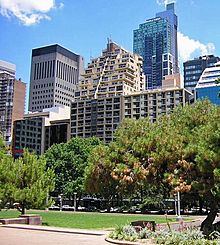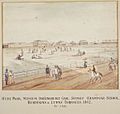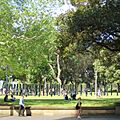Hyde Park, Sydney facts for kids
Quick facts for kids Hyde Park, Sydney |
|
|---|---|

Avenue of Hill's weeping fig in Hyde Park
|
|
| Type | Urban park |
| Location | Central business district () |
| Nearest city | Sydney, New South Wales |
| Area | 16.2 hectares (40 acres) |
| Authorized | 2 November 1810 |
| Etymology | Hyde Park, London |
| Owned by | Sydney City Council |
| Open | 24 hours |
| Status | Open all year |
| Parking | The Domain Car Parking Station |
| Connecting transport | |
| Official name | Hyde Park; Sydney Common; Government Domain; The Common; The Exercising Ground; Cricket Ground; Racecourse |
| Type | State heritage (landscape) |
| Criteria | a., b., c., d., f., g. |
| Designated | 13 December 2011 |
| Reference no. | 1871 |
| Type | Urban Park |
| Category | Parks, Gardens and Trees |
Hyde Park is a super old and important park right in the middle of Sydney, Australia. It's about 16 hectares (that's like 30 football fields!) and is Australia's very first public park. Imagine, it's been a public space since 1810! The park is shaped like a rectangle, with a rounded top end. It's surrounded by busy streets and cool buildings like St Mary's Cathedral and the Australian Museum.
Hyde Park is famous for its beautiful gardens and hundreds of trees, especially the amazing fig trees that line its paths. It's a peaceful green space in the busy city.
Contents
A Look Back: Hyde Park's History
When Europeans first arrived in 1788, this area was a swampy place where Aboriginal people hunted. It was also an important meeting and contest ground for Aboriginal groups from all over the region. They would gather here to settle arguments and hold ceremonies.
The land was first used by settlers to graze animals and collect firewood. It was known as "The Common" because it belonged to everyone, not just the Governor.
How Hyde Park Got Its Name
In 1810, Governor Macquarie officially made it a public park. He named it "Hyde Park" after the famous park in London. He wanted Sydney to have beautiful public spaces, just like big European cities. He also made rules to protect the park, stopping carts and animals from crossing it.
Early Sports and Fun
Hyde Park quickly became Sydney's first sports center! People played cricket, had horse races, and even boxing matches here. British officers introduced cricket in 1803, and it became very popular. The park was used for races until the 1820s.
Governor Macquarie also had important buildings like Hyde Park Barracks and St James Church built around the northern end of the park.
Changes Over Time
In the 1830s, there was a plan to sell off the park for houses, but Governor Bourke stopped it, keeping it as a park for everyone. More streets were built around and through the park, like Park Street.
The first big tree planting happened in 1837. Later, in the 1850s, people wanted to make the park even nicer, like an "English garden." They added statues, fountains, and a bandstand.
In 1857, the Thornton Obelisk was put up. It looks like an ancient Egyptian monument, but it was actually a sewer vent! People jokingly called it "Thornton's Scent Bottle."
Many different types of fig trees were planted in the 1860s, making the park even greener. In 1879, a statue of Captain James Cook was placed on the highest point of the park.
Modernizing the Park
In the early 1900s, the park got lights and even Sydney's first public toilet for women! A huge change happened in the 1920s when the city's underground railway was built right under the park. This meant a lot of digging and construction, but it also brought the St James and Museum train stations to the park's edges.
After the railway work, the park was redesigned to be even more beautiful. This plan included the famous Archibald Fountain at the northern end and the ANZAC War Memorial at the southern end.
Recent Additions
In 1954, Queen Elizabeth II opened the Sandringham Memorial Gardens. In 1983, the Nagoya Gardens were built to celebrate Sydney's friendship with its sister city, Nagoya, Japan.
On March 31, 2015, a special War Memorial for Aboriginal and Torres Strait Islander soldiers was unveiled in Hyde Park South. It features tall, bullet-shaped sculptures and fallen shells, honoring their service.
Sports and Fun in Hyde Park
Hyde Park has always been a place for sports and activities.
Horse Racing
Australia's first official horse race meeting happened in Hyde Park in October 1810! Officers from Governor Macquarie's regiment organized it. The races were a big event, and Governor Macquarie himself attended. These races continued in the park for many years.
Cricket
Cricket was played in Hyde Park as early as 1803. The first fully recorded match was in 1832 between two army regiments. The park was the main cricket ground until 1856.
Boxing
Bareknuckle boxing fights were also held here. The first recorded fight took place near where the War Memorial is today in 1814. It was a tough fight, lasting 56 rounds!
Rugby
In 1865, the very first rugby match in Australia was played in Hyde Park. Later that year, the first game between two different clubs happened here.
By 1856, Hyde Park became more of a public garden, and most organized sports moved to other areas like The Domain.
What You'll See in Hyde Park
<mapframe width="200" height="450" zoom="16" text="Interactive map"> { "type": "ExternalData", "service": "page", "title": "Hyde Park, Sydney.map" } </mapframe> Hyde Park is a mostly flat park in the heart of Sydney. It has lovely shady paths, green grassy areas, and colorful views. The park's design tells stories about Sydney's history.
The main path is lined with magnificent, tall Hill's Weeping Fig trees. These trees are a big part of the park's look. At each end of this path, you'll find two major monuments: the Archibald Fountain in the north and the Anzac Memorial in the south.
Many smaller paths cross the park, connecting different city streets. These paths help people get around and enjoy the park's features.
Famous Monuments and Features
Hyde Park is home to many important statues and memorials:
- Archibald Fountain: This beautiful fountain is at the northern end. It was given to Sydney in 1932 by J.F. Archibald to remember Australia and France's friendship during World War I. It features bronze statues of Greek gods and mythical creatures.
- ANZAC War Memorial: At the southern end, this impressive building honors Australian soldiers who served in World War I. It has amazing sculptures and a peaceful Pool of Reflection.
- Yininmadyemi – Thou didst let fall': Near the Anzac Memorial, this artwork by Tony Albert honors Aboriginal and Torres Strait Islander soldiers. It features large bullet-shaped sculptures.
- Hyde Park Obelisk: Located near Bathurst Street, this tall monument looks like an Egyptian obelisk but is actually a sewer vent from 1857!
- Captain Cook Statue: This statue honors Captain James Cook, who explored Australia's east coast in 1770.
- Sandringham Gardens: On the eastern side, these sunken gardens were opened by Queen Elizabeth II to remember Kings George V and George VI.
- Emden Gun: At the southeastern corner, this gun is from a German ship sunk by an Australian ship in World War I. It's one of Australia's first war trophies.
- Nagoya Gardens: These gardens celebrate Sydney's friendship with Nagoya, Japan, and include a giant outdoor chess set!
Amazing Trees and Plants
The most common trees in Hyde Park are the Hill's Weeping Figs, which create those grand avenues. You can also find Moreton Bay Figs and Port Jackson Figs. Other trees include different types of pines, palms, and oaks.
Sometimes, trees in the park get sick from fungi. When this happens, some trees need to be removed and replaced to keep the park healthy and beautiful for everyone to enjoy.
Why Hyde Park is Special
Hyde Park is super important because it's Australia's oldest public park, first set aside in 1810. It has shaped how Sydney looks and feels. It's a great example of a formal city park, with its planned paths and monuments.
The park has seen many historical events, from early sports to protests and celebrations. It holds many memorials that remind us of important people and events in Australia's history, especially the Anzac Memorial, which is very special to families of soldiers.
Hyde Park is a rare and unique place. It's one of the oldest public spaces in Sydney and has a special design. It also has some very old and unique monuments, like the John Baptist Fountain, which is the oldest ornamental fountain in Sydney. The Archibald Fountain is also a one-of-a-kind artwork in Australia.
Hyde Park is a much-loved park that has inspired many other parks in Australian cities and towns.
Gallery
-
The Obelisk (early 1900s)
-
Captain Cook statue by Thomas Woolner
See also

















